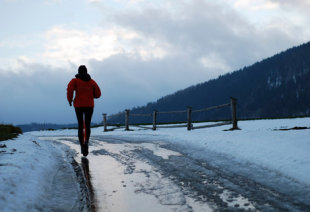
Photo: Thinkstock
Congrats on bravely deciding to keep exercising during the darkest, coldest, rainiest months. Now, before you head out...
1. Don't Throw on an Old Pair of Sweats for a Twilight or Dusk Jog
Exercising in the dark-or at least starting or ending your workout in the dark-is a tough reality for many during the winter (for instance, right now Chicago gets just nine hours and seven minutes of daylight). Save the comfy sweats for after your workout, though.
RELATED: The Insomniac's 3 A.M. Yoga Routine
Do choose something with reflective strips on the arms and legs (not the back or torso). When you're running or walking outside, those body parts will be in motion, making it easier for drivers to see you. Nike's Vapor Flash Jacket and Swift Tight will make you impossible to miss. During the day, wearing eye-catching colors not found in nature will make you more visible. A neon top may even come in handy if you wind up taking a wrong turn and get lost. Laurence Gonzales, author of Deep Survival: Who Lives, Who Dies, and Why, knew someone who got lost in Rocky Mountain National Park and was rescued because he hung his bright blue coat on a tree and a helicopter saw it.
RELATED: 5 Resolutions Bob Greene Says You Shouldn't Make This Year
2. Don't Go for the Michelin Man Look
John Stanton, founder of Running Room (a chain of running stores in the U.S. and Canada), has finished some 60 marathons and exercised in temperatures as low as 40° below zero. While he doesn't recommend such extreme conditions for the rest of us, he does have some useful advice for bundling up-and it involves making sure you don't overbundle. You'll start to sweat, and your clothes will become damp. At best, too many layers of cold, wet clothing can set you up for a very uncomfortable workout; at worst, they put you at risk for hypothermia, which can occur above 40° if you become chilled from rain or sweat.
RELATED: 7 Exercise Excuses That Just Ran Out of Juice
Do follow this rule of thumb: Dress as if it were 10 degrees warmer, so if it's 35° outside, put on clothing appropriate for 45°. Once you start moving, your body will warm up. And the more you exercise outside, the better your body will get at dealing with the cold, as a scientist known as Professor Popsicle explains in this video.
RELATED:
3. Don't Stash Your Phone in Your Pants Pocket
It's smart to carry a phone while exercising outdoors in the winter; even if nothing terrible happens, you might just be ready to call it quits-3 miles from home. However, it's important to put your phone someplace you know will stay dry in rain, sleet or snow.
Do look for jacket or pants pockets that zip shut and are fully waterproof when closed. Oiselle's Burke Jacket, in orange or white, has two waterproof side pockets that are each big enough for a phone.
RELATED: Everything You Always Wanted to Know About Spin Class but Were Afraid to Ask
4. Don't Put Your Wet Sneakers on Top of the Radiator to Dry
In many areas of the country (the Pacific Northwest, the Mid-Atlantic, and parts of New England and the Midwest), November to January are the rainiest months. Chances are, if you're hardy enough to exercise in the rain, you'll be dealing with soggy sneakers at some point. Stanton has tried all kinds of strategies for drying his out (including putting shoes in the dryer-a big mistake, since the heat melted the glue).
Do stuff newspaper inside wet sneakers-Stanton swears this works best.
KEEP READING: More Dos and Don'ts of Winter Workouts
More from Oprah.com:
• The 13 fastest dinners on the planet
• January's best beauty buys
• 7 foolproof rules for changing your diet
• How to embrace your crazy, chaotic life
• Subscribe to O, The Oprah Magazine and save up to 78%
Like O, The Oprah Magazine on Facebook
No comments:
Post a Comment